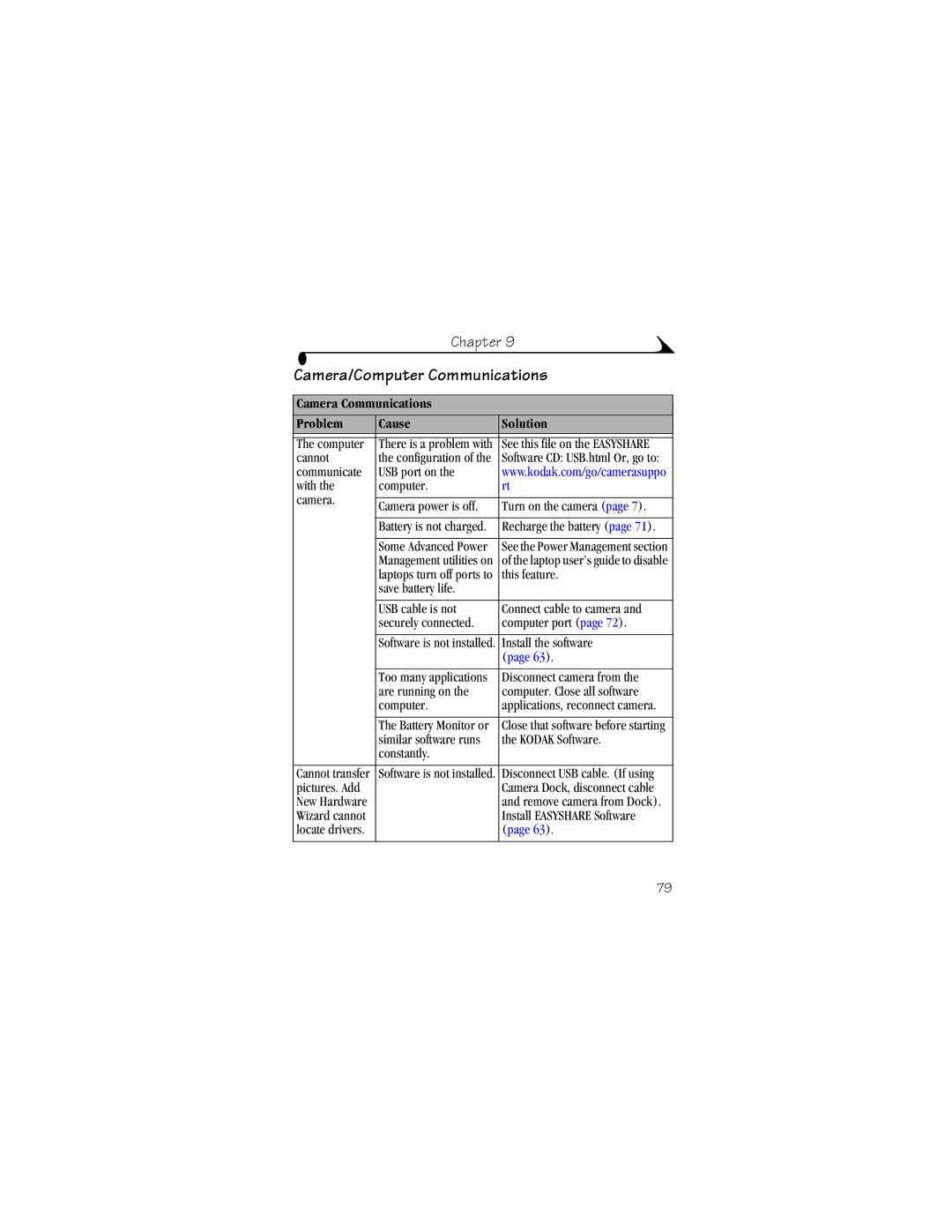Kodak Easyshare
Eastman Kodak Company 343 State Street Rochester, New York
Front View
Back View
Side Views
Bottom View
Table of Contents
Liveview-Using the LCD to Frame Your Subject
Vii
Formatting Internal Memory or MMC/SD Card
Appendix
Page
Getting Started
Install Software First
Need This Guide in Larger Print?
What Can I Do With My Digital Pictures and Videos?
What Can I Do With My Camera?
Package
Attaching the Wrist Strap
Using the AC Adapter
Loading the Battery
Mode Dial Settings
Turn off the camera
Adjusting the Display
Turning On the Camera
Do This
Setting the Date and Time
Status Bar Icons Top of LCD
Checking Camera Status Bar
Screen Icons Bottom of LCD
Inserting an MMC/SD Card
Choosing Internal Memory or MMC/SD Card
Managing Your Storage Location Setting
Adding Optional Lenses
Checking Your Storage Setting
Checking a Picture or Video’s Location
Taking Pictures
Taking Pictures in Auto Mode
Default flash setting
Available flash settings
Taking Pictures in Sport
Using the Low Light Auto Focus LED
Taking Pictures in Night Mode
Press the Shutter button half-wayto set Exposure
Taking Pictures in Landscape Mode
Taking Pictures in Close-up Mode
Liveview-Using the LCD to Frame Your Subject
Review it If you take no action, the picture is saved
Quickview-Reviewing the Picture Just Taken
While Shutter Button is Pressed Half-way
Using the Auto Focus Framing Marks
Using the Advanced Digital Zoom
Using the Optical Zoom
Flash Range
Using the Flash
Other Flash Screen Information
Flash Settings In Each Mode
Icon Mode Default Available
Setting Auto
Putting Yourself in the Picture
Turn On Burst
Taking a Burst Series of Pictures
Take the Pictures
Still Menus
Setting Exposure Compensation
Setting White Balance
Highlight an option
Setting Picture Quality
Black & White-forblack-and-white pictures
Setting Color Mode
Setting Exposure Metering
See Using the Auto Focus Framing Marks,
Setting Focus Zone
Setting ISO Speed
Set Long Time Exposure
Setting Long Time Exposure
Take the Picture
Placing the Date on Pictures
Other Features
Setting the Orientation Sensor
Taking a Video
Taking Videos
Quickview-Reviewing the Video Just Taken
Video Menus
Putting Yourself in the Video
Picture and Video Icons
Reviewing Pictures and Videos
Viewing Multiple Pictures and Videos
Viewing Single Pictures and Videos
Deleting Pictures and Videos
Playing a Video
Magnifying Pictures
Review Menus
Protecting Pictures and Videos From Deletion
Starting the Slide Show
Running a Slide Show
Changing the Slide Show Display Interval
Displaying Pictures and Videos on a Television
Turning On Slide Show Loop
Picture or VIDEO-copies the current picture
Copying Pictures and Videos
Before you copy, make sure that
Copy pictures or videos
Viewing Picture/Video Information
Displaying Video Date
Page
Tagged Pictures
Tagging Pictures and Videos
Tagged Videos
Printing Tagged Pictures
Tagging Pictures for Printing
Emailing Tagged Pictures and Videos
Tagging Pictures and Videos for Emailing
Tagging Pictures and Videos as Favorites
Using Favorites On Your Computer
To Access Setup Mode/Menus
Customizing Your Camera Settings
Setup Menus
Turning Off Quickview
Changing the Print Quantity Default
Turning Off the Shutter Sound
Turning On Liveview in Still Modes
Turning Off the Low Light Auto Focus LED
Setting Video Out
Selecting a Language
Formatting Internal Memory or MMC/SD Card
Changing Advanced Digital Zoom
Viewing Camera Information
Page
Windows System Requirements
Installing the Software
MAC OS 8.6 and 9.x System Requirements
MAC OS X System Requirements
MAC OS 8.6 or 9.x-on the install window, click Continue
Install the Software
Chapter
Using the Easyshare LS443 Camera Dock
Connecting to the Computer
Connecting the Camera Dock
Docking the Camera
Transferring Pictures and Videos
Charging the Battery
Transferring Pictures and Videos to Your Computer
Connecting With the USB Cable
Printing From an MMC/SD Card
Printing Pictures from Your Computer
Ordering Prints Online
Page
Camera Problem Cause Solution
Troubleshooting
Troubleshooting-Camera
Camera Problems
LCD
Picture is too Flash is not on Turn on the flash Dark
Picture is not Lens is dirty Clean the lens Clear
Camera/Computer Communications
Camera Communications Problem Cause Solution
MMC/SD Cards and Internal Memory
MMC/SD Cards and Internal Memory Problem Cause Solution
Camera LCD Messages
LCD Messages Cause Solution
Card is protected Switch on card is
High camera Internal
Camera Ready Light Status
Camera Ready Light Problem Cause Solution
Camera processing
Camera Dock Problems
Troubleshooting-Camera Dock
Camera Dock Problem Cause Solution
Camera Dock Lights
Camera Dock Light Status
Page
Software Help
Getting Help
Helpful Web Links
Help in this Manual
Before You Call
Telephone Customer Support
Telephone Numbers
Spain/Espana 91 749 76 Sweden/Sverige 08 587 704
Appendix
Camera Specifications
Kodak Easyshare LS443 Zoom Digital Camera
5V DC
Landscape, Close-up, Video Flash Off
Original Factory Settings-Camera
Feature Factory Setting
Sport, Night Auto
Chapter
Picture Storage Capacity
Storage Capacities
Video Storage Capacity
Card File Naming Conventions
Locating Pictures and Videos on a Card
Burst Pictures
Using the Battery
FCC Compliance and Advisory
Power-Saving Features
Expected Battery Life
Regulatory Information
Canadian DOC Statement
Index
Date
Help
LCD
File name conventions, 98 formatting, 60 inserting
Quality
Tagging
Zoom

